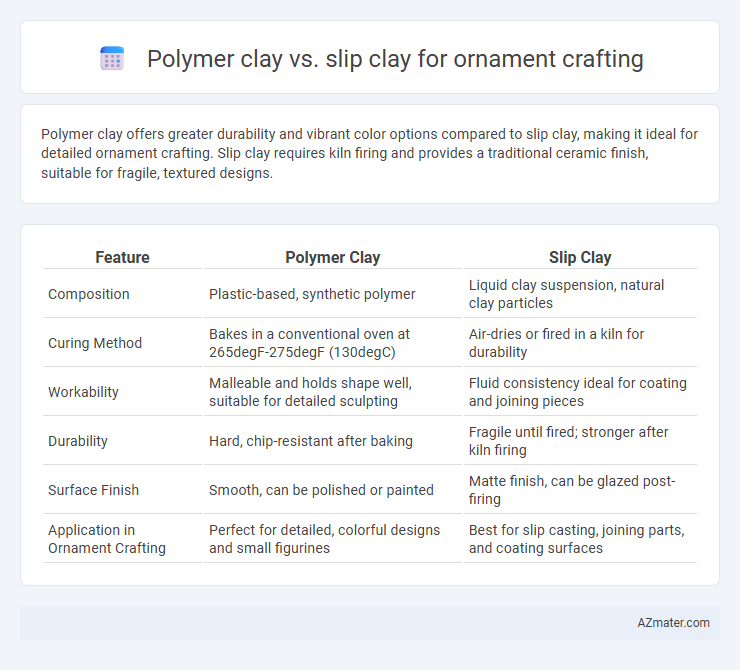Polymer clay offers greater durability and vibrant color options compared to slip clay, making it ideal for detailed ornament crafting. Slip clay requires kiln firing and provides a traditional ceramic finish, suitable for fragile, textured designs.
Table of Comparison
| Feature | Polymer Clay | Slip Clay |
|---|---|---|
| Composition | Plastic-based, synthetic polymer | Liquid clay suspension, natural clay particles |
| Curing Method | Bakes in a conventional oven at 265degF-275degF (130degC) | Air-dries or fired in a kiln for durability |
| Workability | Malleable and holds shape well, suitable for detailed sculpting | Fluid consistency ideal for coating and joining pieces |
| Durability | Hard, chip-resistant after baking | Fragile until fired; stronger after kiln firing |
| Surface Finish | Smooth, can be polished or painted | Matte finish, can be glazed post-firing |
| Application in Ornament Crafting | Perfect for detailed, colorful designs and small figurines | Best for slip casting, joining parts, and coating surfaces |
Introduction to Ornament Crafting with Clays
Polymer clay and slip clay are popular materials for ornament crafting, each offering unique properties suited to different techniques. Polymer clay is a versatile, oven-bake material that allows detailed sculpting, vibrant colors, and durable finishes, ideal for custom, lightweight ornaments. Slip clay, a liquid form of traditional ceramic clay, is used primarily for slip casting and surface decoration, requiring kiln firing to achieve hard, fragile results perfect for intricate, delicate ornaments.
What is Polymer Clay?
Polymer clay is a versatile, synthetic modeling material composed of polyvinyl chloride (PVC) and plasticizers, known for its pliability and ability to harden permanently when baked at low temperatures. It offers vibrant colors, fine detailing, and durability, making it ideal for crafting intricate ornaments with a smooth finish. Unlike slip clay, polymer clay requires no water for shaping and provides excellent resistance to cracking and breaking once cured.
What is Slip Clay?
Slip clay is a liquid mixture of clay and water used primarily in ceramics for joining pieces or creating decorative textures; it acts as a strong adhesive that bonds clay parts before firing. Unlike polymer clay, which is a synthetic, pliable material cured by baking, slip clay is traditionally crafted from natural clay and requires kiln firing to harden permanently. Slip clay's versatility in sculpting fine details and its compatibility with various ceramic techniques make it ideal for intricate ornament crafting.
Material Composition: Polymer vs Slip Clay
Polymer clay is a synthetic modeling material composed primarily of polyvinyl chloride (PVC) combined with plasticizers, offering flexibility and durability after baking. Slip clay, made from a suspension of fine clay particles and water, relies on natural minerals like kaolin and feldspar, providing a traditional ceramic texture that hardens through firing. The distinct material compositions affect their crafting properties, with polymer clay suited for detailed, colorful ornaments and slip clay ideal for creating classic, glazed ceramic finishes.
Workability and Crafting Techniques
Polymer clay offers excellent workability with its pliable texture, allowing detailed sculpting and easy blending of colors, ideal for intricate ornament designs. Slip clay, a liquid mixture of clay and water, excels in techniques like slip casting and attaching pieces seamlessly, providing smooth surfaces and fine detail through molding. While polymer clay cures with heat for durability, slip clay requires kiln firing, influencing the choice based on the crafting process and desired finish.
Drying and Curing Processes
Polymer clay requires baking at a low temperature, typically around 265degF to 275degF (130degC), for 15 to 30 minutes depending on thickness, ensuring it hardens without cracking. Slip clay, used in ceramics, involves air drying followed by kiln firing at temperatures exceeding 1,800degF (980degC), which vitrifies the clay and makes it durable and water-resistant. The significant difference in drying and curing processes affects the final strength and finish of ornaments, with polymer clay offering quick home curing and slip clay demanding professional kiln access.
Durability and Finished Ornament Quality
Polymer clay offers superior durability compared to slip clay, making it ideal for long-lasting ornaments resistant to chipping and cracking. The finished quality of polymer clay ornaments is smooth, vibrant, and allows for intricate detailing, ensuring a professional appearance. Slip clay, often used in traditional ceramics, tends to be more fragile and porous after firing, which can affect the longevity and finish of decorative pieces.
Surface Finishing and Decoration Options
Polymer clay offers a smooth, malleable surface ideal for intricate surface textures and vibrant paint applications, allowing detailed decoration with acrylics, pastels, and metallic powders. Slip clay provides a more porous and matte finish, suitable for glazing and traditional ceramic painting techniques that can create rich, layered effects after firing. Both materials support surface embellishments like embossing and stamping, but polymer clay enables finer precision and a wider variety of color treatments without requiring kiln firing.
Safety and Handling Considerations
Polymer clay offers non-toxic formulations ideal for indoor crafting with minimal handling risks, but requires baking at specified temperatures to cure safely. Slip clay, made from natural ceramic materials, demands caution during mixing and firing processes due to potential dust inhalation and kiln usage, emphasizing proper ventilation and protective gear. Both materials necessitate careful storage to prevent contamination and maintain work environment safety for artisan health.
Cost and Accessibility Comparison
Polymer clay generally costs more per pound than slip clay but offers greater accessibility through craft stores and online retailers, making it widely available for hobbyists. Slip clay, typically derived from natural clay mixed with water, is more affordable and commonly used in pottery studios or educational settings where raw materials and tools are bulk-purchased. The choice between polymer and slip clay depends on budget constraints and the availability of specialized equipment, with polymer clay requiring no kiln while slip clay often does.

Infographic: Polymer clay vs Slip clay for Ornament crafting
 azmater.com
azmater.com